This is a list of the most notable films produced in the Cinema of Germany in 1935.
This is a list of the most notable films produced in the Cinema of Germany in 1935.
| Title | Director | Cast | Genre | Notes |
|---|---|---|---|---|
| Achte mir auf Gakeki | Alwin Elling | Hermann Braun, Erich Fiedler, Heinz Flügge | Short film | |
| Das blaue Wunder | Hans Fischerkoesen | animation | ||
| Die Bremer Stadtmusikanten | Ferdinand Diehl | animation | ||
| Das Erbe | Carl Hartmann | Short | The Inheritance, propaganda for euthanasia and sterilization | |
| Galathea: Das lebende Marmorbild | Lotte Reiniger | animation | ||
| Lichtkonzert No. 2 | Oskar Fischinger | Animation | ||
| Kalif Storch | Lotte Reiniger | animation | ||
| Eine kleine Königstragödie | Richard Groschopp | animation | ||
| Der kleine Schornsteinfeger | Lotte Reiniger | animation | ||
| Komposition in Blau | Oskar Fischinger | Animation | Composition in Blue; In Gasparcolor | |
| Muratti privat | Oskar Fischinger | Animation | ||
| Nordmark voran! | Richard Garms | Animation | ||
| Papageno | Lotte Reiniger | Animation | ||

Triumph of the Will is a 1935 German Nazi propaganda film directed, produced, edited and co-written by Leni Riefenstahl. Adolf Hitler commissioned the film and served as an unofficial executive producer; his name appears in the opening titles. It chronicles the 1934 Nazi Party Congress in Nuremberg, which was attended by more than 700,000 Nazi supporters. The film contains excerpts of speeches given by Nazi leaders at the Congress, including Hitler, Rudolf Hess and Julius Streicher, interspersed with footage of massed Sturmabteilung (SA) and Schutzstaffel (SS) troops and public reaction. Its overriding theme is the return of Germany as a great power with Hitler as its leader. The film was produced after the Night of the Long Knives, and many formerly prominent SA members are absent.

The 1930s was a decade that began on January 1, 1930, and ended on December 31, 1939. In the United States, the Dust Bowl led to the nickname the "Dirty Thirties".

Ernst Lubitsch was a German-born American film director, producer, writer, and actor. His urbane comedies of manners gave him the reputation of being Hollywood's most elegant and sophisticated director; as his prestige grew, his films were promoted as having "the Lubitsch touch". Among his best known works are Trouble in Paradise (1932), Design for Living (1933), Ninotchka (1939), The Shop Around the Corner (1940), To Be or Not to Be (1942) and Heaven Can Wait (1943).

Douglas Sirk was a German film director best known for his work in Hollywood melodramas of the 1950s. However, he also directed comedies, westerns, and war films. Sirk started his career in Germany as a stage and screen director, but he left for Hollywood in 1937 after his Jewish wife was persecuted by the Nazis.
Robert Florey was a French-American director, screenwriter, film journalist and actor.

The Nuremberg rallies were a series of celebratory events coordinated by the Nazi Party in Germany. The first Nazi Nuremberg rally took place in 1923. This rally was not particularly large and did not have much impact; however, as the party grew in size, the rallies became more elaborate and featured larger crowds. They played a seminal role in Nazi propaganda events, conveying a unified and strong Germany under Nazi control. The rallies became a national event once Adolf Hitler rose to power in 1933, when they became annual occurrences. Once the Nazi dictatorship was firmly established, the party's propagandists began filming them for a national and international audience. Nazi filmmaker Leni Riefenstahl produced some of her best known work including Triumph of the Will (1934) and The Victory of Faith (1933), both filmed at the Nazi party rally grounds near Nuremberg. The party's 1938 Nuremberg rally celebrated the Anschluss that occurred earlier that year. The 1939 scheduled rally was cancelled just before Germany's invasion of Poland and the Nazi regime never held another one due to the prioritization of Germany's efforts in the Second World War.
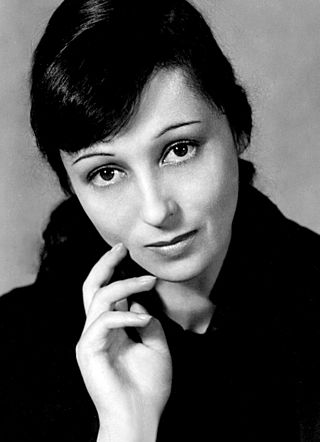
Luise Rainer was a German-born film actress. She was the first thespian to win multiple Academy Awards, and the first to win back-to-back; at the time of her death, thirteen days shy of her 105th birthday, she was the longest-lived Oscar recipient, a superlative that has not been exceeded, as of 2024.

Veit Harlan was a German film director and actor. Harlan reached the highpoint of his career as a director in the Nazi era; most notably his antisemitic film Jud Süß (1940) makes him controversial. While viewed critically for his ideologies, a number of critics consider him a capable director on the grounds of such work as Opfergang (1944).
Hans Dreier was a German motion picture art director. He was Paramount Pictures' supervising art director from 1927 until his retirement in 1950, when he was succeeded by Hal Pereira.

Der Sieg des Glaubens is the first Nazi propaganda film directed by Leni Riefenstahl. Her film recounts the Fifth Party Rally of the Nazi Party, which occurred in Nuremberg, Germany, from 30 August to 3 September 1933. The film is of great historic interest because it shows Adolf Hitler and Ernst Röhm on close and intimate terms, before Hitler had Röhm killed during the Night of the Long Knives on 1 July 1934. As he then sought to remove Röhm from German history, Hitler ordered all known copies of the film be destroyed, and it was considered lost until a surviving copy was found in the 1980s in East Germany.
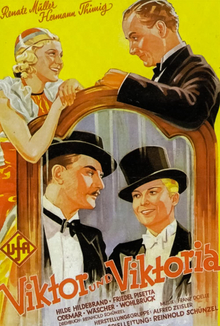
Victor and Victoria is a 1933 German musical comedy film written and directed by Reinhold Schünzel, starring Renate Müller as a woman pretending to be a female impersonator. The following year, Schünzel directed a French-language version of the film titled George and Georgette, starring Meg Lemonnier and a French cast.
Alfred Junge was a German-born production designer who spent a large part of his career working in the British film industry.

Michael Ballhaus, A.S.C. was a German cinematographer who collaborated with directors such as Rainer Werner Fassbinder, Martin Scorsese, Mike Nichols, James L. Brooks, and Wolfgang Petersen. He was a member of both the Academy of Arts, Berlin, and the American Society of Cinematographers.
Fritz Maurischat was a German production designer. He made his film debut in 1924. Over the next 38 years, he worked on over 70 films, all of them in his native Germany.
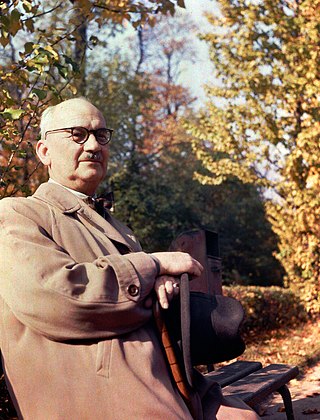
Dufaycolor is an early British additive colour photographic film process, introduced for motion picture use in 1932 and for still photography in 1935. It was derived from Louis Dufay's Dioptichrome plates, a glass-based product for colour still photography, introduced in France in 1909. Both Dioptichrome and Dufaycolor worked on the same principles as the Autochrome process, but achieved their results using a layer of tiny colour filter elements arrayed in a regular geometric pattern, unlike Autochrome's random array of coloured starch grains. The manufacture of Dufaycolor film ended in the late 1950s.
Mascot Pictures Corporation was an American film company of the 1920s and 1930s, best known for producing and distributing film serials and B-westerns. Mascot was formed in 1927 by film producer Nat Levine. In 1935, it merged with several other companies to form Republic Pictures.

Carl August Hugo Froelich was a German film pioneer and film director. He was born and died in Berlin.
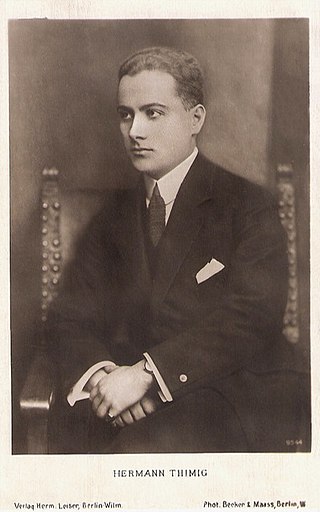
Hermann Thimig was an Austrian stage and film actor. He appeared in 102 films between 1916 and 1967.
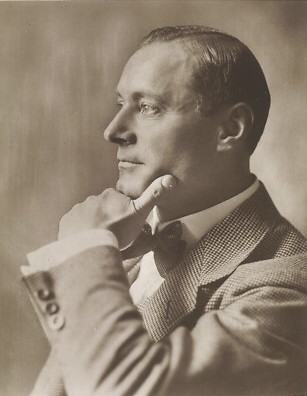
Heinrich August Franz Schroth was a German stage and film actor.
Operetta films are a genre of musical films associated with, but not exclusive to, German language cinema. The genre began in the late 1920s, but its roots stretch back into the tradition of nineteenth century Viennese operettas.